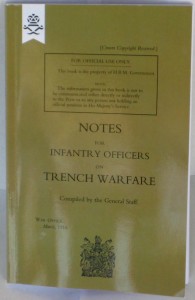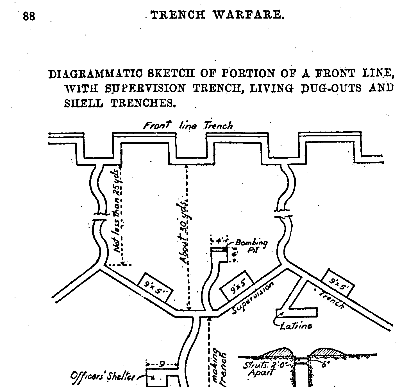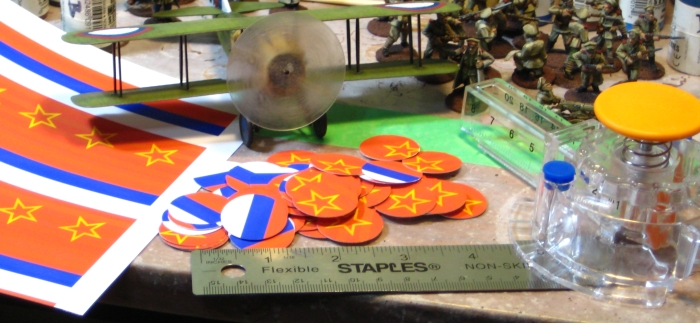“The importance assumed by trench warfare… have rendered necessary special instructions in the details of trench construction and trench fighting.” — Ch1:1, Notes
This is a modern facsimile reprint of an official 1916 British War Office publication, published by Naval & Military Press. You can find scanned PDF versions of this document online, but I took advantage of NMP’s Easter sale to get a printed version very, very cheaply. It’s a small paperback, roughly 7″x5″ and 78 pages long. (I talked about my experience ordering from NMP previously.)
It was compiled by the British General Staff in March 1916 as a training and reference guide for, as the title says, officers in the trenches of the Western Front. The five chapters comprise an introduction, a long chapter on the construction and maintenance of trenches, the daily routine of trench warfare, defending trenches, and finally the attack in trench warfare. The book finishes off with a couple of appendices, thirty-five diagrams, and a short index.
The writers repeatedly remind the reader that trench warfare is “only a phase of operations“, and that “(t)he aim of trench fighting is, therefore, to create a favourable situation for field operations, which the troops must be capable of turning to account.” While this is technically true, it took until the last few months of the war in late 1918 to come true, and remember that Notes was published in March of 1916 — that trench-bound “phase of operations” lasted nearly two and a half years…
From a wargamer’s point of view, there are two major ways that books like this are valuable. The first is for period flavour and scenario inspiration; something as simple as knowing how a trench network was laid out or the basics of how it could be attacked or defended can inspire a scenario. Small details like the note in the appendix on communication on not routinely taking field telephones right up to the forwardmost trenches, lest the trench be rushed and the enemy able to tap into the field telephone network without anyone being the wiser back at headquarters could inspire quite detailed trench-raid scenarios, with more detailed and more interesting objectives than simply “kill the other guy”.
The second (and related, of course) way this type of book is useful to wargamers comes mostly in those 35 or so diagrams in the back of this little booklet. If you’re considering building trench scenery or fieldworks of any sort, knowing the “standard” ways the British Army expected things to be done is obviously valuable. The diagrams cover frontline, support, and communication trenches, various sorts of dugouts, several types of machine-gun nest, wire and obstacles, and more. If you’re going to pull a Roundwood and build up a bunch of trench boards, this inexpensive little booklet could be a valuable starting point.
Notes for Infantry Officers on Trench Warfare, (British) War Office, 1916, reprinted by Naval & Military Press. £7.50
The Shortest Possible Review: If you want a basic WW1 Western Front reference, get this.
Note that there is also a May 1917 version of this booklet, with exactly the same title, but printed by the American War Department as they geared up to finally join the Great War. As far as I can tell the text is largely identical to the earlier British edition discussed above, but the value of the later American version is the hugely expanded number of diagrams in the back. The book has gone up to about 160 pages from 75 or so, and a huge amount of that is new diagrams. You can download a good, complete PDF of the War Department version over on the US Army’s Combined Arms Research Library website – Notes for Infantry Officers on Trench Warfare 1917. To get the PDF version easily, use the blue “Download” button on the far right-hand side of the screen.




